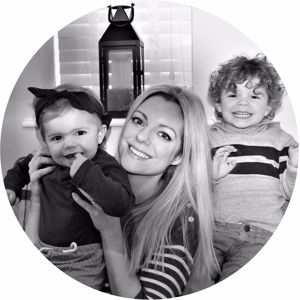Before I became a parent, I worked as a Primary School Teacher specialising in the EYFS. I also co-ordinated the ICT for the school and had successfully run a Reception class blog, whilst helping and encouraging other classes to do the same. I have a huge passion for ‘learning through play’ and helping children to learn in a fun and independent way. I was ready to take my next step up the career ladder when, boom. 2 blue lines. A bun was in the oven.
I had convinced myself that not much would change (everything changed!) and that I would work up until my due date just before Xmas and then return to teach a brand new class the following September. Of course, I was kidding myself. There were lots of reasons why it became impossible for me to return to my position as Reception Class Teacher within my school, and you can find out more about why I didn’t return to Teaching after having my children here. Ultimately though, there were a number of key factors I had to weigh up when I was attempting to make my decision. I am sure these will feel familiar if you too are in the same position:
1. Childcare – is it available to suit your hours? Can you afford it?
2. Work-life balance – Do you stop work when you leave the building or is more required of you?
3. Emergencies – How far away are you and how easily can you get back to your child if needs be?
4. Returning role – are you slotting back into the same familiar job or have things changed?
5. Breastfeeding – Do you have a job which easily allows for expressing milk?
6. Do you want to return to work?
For me personally, I would have been working simply to pay for childcare, there was no surplus. I would have had to take work home with me in the evenings and at weekends and with my husband often working away, emergency care would have been difficult. My role had completely changed, so the familiar ground had been whisked away and replaced by something entirely different. When my request for a part-time return was denied, I was forced to consider a plan B…
I can’t deny that there was an element of relief when the decision not to return to my previous role had been made. The changes that were occurring within the school moving towards a more formal set up for Early Years teaching was soul-destroying. It was stressful before I had a baby to look after, I’ve no doubt it would have been a hundred times worse after. It was nice to have some breathing space to really assess what I wanted to do next and to work out how I could do this whilst still being a mum to my little boy. I struggled with PTSD and hypervigilance after a traumatic labour, and the thought of leaving my child with someone else really affected me. I decided that rather than look for another teaching position, I would try to find a job which would allow me to work and also be a mum.
What were my options for an alternative career?
I thought long and hard about this one, researching for hours on end - which even inspired a blog series on my website called ‘Children Changing Careers’ where I interviewed different working mums every week about their previous roles and what they decided to do after having children. It made me realise that there were SO many options out there depending on how creative you could be, or what level of support you had behind the scenes.
I narrowed my own choices down to 2 very specific options, in line with my previous career experience:
1. Childminding
2. Nannying
Childminding
Unlike Nannies, Childminders look after children within their own homes. They have to undergo training and qualifications and they are bound by the Early Years Foundation Stage for under 5’s (like Teachers) and are inspected by Ofsted. There are health and safety requirements and insurance costs to consider, as well as initial start-up costs. Childminders are also subject to basic childminding ratios, which means that they can look after a maximum of 6 children up to the age of 8yrs, but only three of them can be under the age of 5yrs and only one can be under the age of 1yr. This includes their own children – so at the time this meant I could only look after my own child and two other 2-4-year-olds during the day.
I went along to a childminding information day at my local council, in order to find out all of the information I needed in order to get started. I already had the relevant qualifications and experience for working within the EYFS, and I discovered that if I conducted certain amounts of market research locally and could prove there was a need, then I would be eligible for funding!
I spent hours collating data and filling in questionnaires with local parents. I knew there was a need because I had been unable to find a childminder with a free space myself when I was looking for one…but unfortunately, because I live in an ‘affluent’ area, my request for funding was denied. I needed to save up for the start-up costs, so moved on to my next option in the meantime which was…
Nannying
You don’t need a qualification to work as a Nanny, but most families prefer it. Nannies work within the home of the child they are caring for, at previously agreed hours and days to suit the family. The child I nannied for was the same age as my little boy, who I took with me, so this worked perfectly. Some nannies choose to be Ofsted registered and set themselves up as a formal childcare provider so that families are able to use childcare vouchers, but this isn’t common. Most Nannies are self-employed. I was an ‘employed’ Nanny as the family I worked for had their own business so I was simply added to the payroll and all tax and NI was paid automatically.
I undertook this role until I was halfway through my pregnancy with my second child, and it worked really well. In the end, I decided not to use the money I had saved up to become a childminder within my own home. I put the savings towards a playroom extension on our house – we needed the extra space now that we have 2 children, and my obsession with ‘learning through play’ resources needed some level of containment!
I’m not sure what my plan C will be, but for now, I am enjoying being a stay at home mummy, whilst doing some blogging work and freelance writing around the children!
Sarah x







